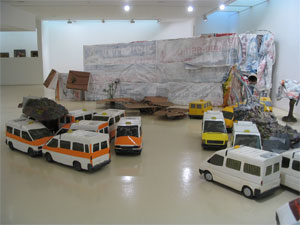An alternative to the monopolized Israeli bus companies, the minibus offers its passengers the comfort of deviation from the fixed route and the flexibility of non-official stops. In the Palestinian territories the minibuses’ struggle for survival is heightened. These vehicles provide a solution to a difficult reality: they succeed in circumventing military checkpoints, ditches and fences. Border devices are elements devised by the Israeli government as a part of the “war against terror”. This extensive project is also known as the “separation fence” currently being built, whose route is altered frequently due to constantly changing political and military decisions. The border-block consists of architectural elements, such as tunnels, bridges, concrete walls and blocs, ditches, bypassing roads, etc. The entire area is filled with constantly changing tangled lines. These changing architectural elements also emerge inside Israel in the form of highway gardens and acoustic walls that separate different communities.
The minibus can potentially blur and transgress these borders; the meeting points between them are akin to those between an arena and players, a figure and a hazy background. The ability to transgress these “soft borders” is as subversive as terror itself.
The exhibition consists of two parts: an installation and a study room next to it, offering a slide show on four monitors, texts, diagrams and documents that have cumulated during the observation process.
The text “Islands” by Anselm Franke and Eyal Weizman appears in the exhibition catalogue
The photographs at Beit Iba and Khirbet Jbarah were taken by Karin Eliyahu
Sound: Finkelstein
Less Reading...
